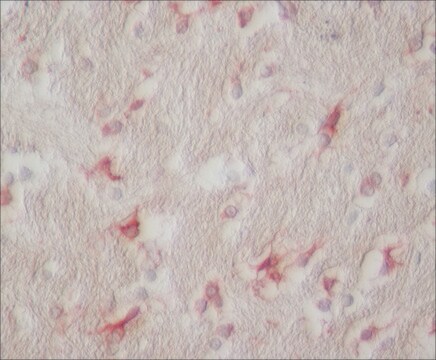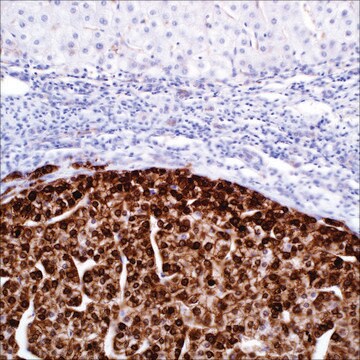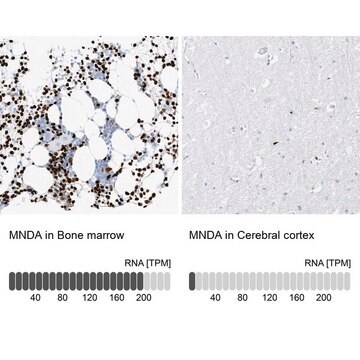一般說明
We are committed to bringing you greener alternative products, which adhere to one or more of The 12 Principles of Green Chemistry. This antibody is Preservative-free, produced without the harm or sacrifice of animals and exceptionally stable to allow for ambient shipping and storage if needed and thus aligns with "Waste Prevention", "Designing Safer Chemicals" and "Design for Energy Efficiency".
Click here for more information.
ZooMAb® antibodies represent an entirely new generation of recombinant monoclonal antibodies. Each ZooMAb® antibody is manufactured using our proprietary recombinant expression system, purified to homogeneity, and precisely dispensed to produce robust and highly reproducible lot-to-lot consistency. Only top-performing clones are released for use by researchers. Each antibody is validated for high specificity and affinity across multiple applications, including its most commonly used application. ZooMAb® antibodies are reliably available and ready to ship when you need them.
特異性
Clone 1D15 is a ZooMAb® rabbit recombinant monoclonal antibody that specifically detects Glutamine Synthase. It targets an epitope within 15 amino acids from the C-terminal region.
免疫原
KLH-conjugated linear peptide corresponding to 15 amino acids from the C-terminal region of human Glutamine Synthase.
應用
Quality Control Testing
Evaluated by Western Blotting in Rat brain tissue lysate.
Western Blotting Analysis: A 1:1,000 dilution of this antibody detected Glutamine Synthetase in Rat brain tissue lysate.
Tested Applications
Western Blotting Analysis: A 1:1,000 dilution from a representative lot detected Glutamine Synthetase in lysates from U87-MG cells and Human brain tissue and Mouse brain tissue.
Affinity Binding Assay: A representative lot of this antibody bound Glutamine Synthetase peptide with a KD of 1.1 x 10-9 in an affinity binding assay.
Immunocytochemistry Analysis: A 1:100 dilution from a representative lot detected Glutamine Synthetase in Jurkat cells.
Immunohistochemistry (Paraffin) Analysis: A 1:100 dilution from a representative lot detected Glutamine Synthetase in Human cerebral cortex tissue sections.
Immunofluorescence Analysis: A 1:100 dilution from a representative lot detected Glutamine Synthetase in Human cerebral cortex tissue sections.
Note: Actual optimal working dilutions must be determined by end user as specimens, and experimental conditions may vary with the end user.
標靶描述
Glutamine synthetase (UniProt: P15104; also known as EC:6.3.1.2, GS, Glutamate--ammonia ligase, Palmitoyltransferase GLUL) is encoded by the GLUL (also known as GLNS) gene (Gene ID: 2752) in human. Glutamine synthetase (GS), a decameric enzyme composed of two pentamers, is a crucial enzyme that eliminates both toxic ammonia and neurotoxic glutamate by combining them to form glutamine that serves as a building block for the biosynthesis of several metabolites. Its active site is inserted in the interface between adjacent monomers, within the same pentameric ring. Independently of its glutamine synthetase activity, GS is also required for endothelial cell migration during vascular development. Three different types of GS have been described (GS1, II, and III). In mammals, GSII is the most common type. Its expression is observed in endothelial cells and it is mainly localized in the cytosol, with a fraction associated with the cell membrane. Its catalytic mechanism involves a two-phase reaction cycle. During phase 1, GS activates the reactants (ammonia and glutamate) with high efficiency, through NH4+ deprotonation by glutamic acid 305 and glutamate phosphorylation by ATP. Phase 2 is the rate limiting step and, in this phase, NH3 attacks the -glutamyl phosphate being concomitantly deprotonated by the leaving PO4 , forming the glutamine and HPO4 products. Mutations in GLUL gene is known to cause Congenital systemic glutamine deficiency (CSGD), a rare developmental disorder with severe brain malformation resulting in multi-organ failure and neonatal death. This ZooMAb® recombinant monoclonal antibody, generated by our propriety technology, offers significantly enhanced specificity, affinity, reproducibility, and stability over conventional monoclonals. (Ref.: Eelen, G., et al. (2018). Nature. 561(7721); 63-69; Moreira, C., et al. (2017). J. Phys. Chem. B. 121(26); 6313-6320; Haberle, J., et al. (2005). N. Engl. J. Med. 353(18); 1926-1933).
外觀
Purified recombinant rabbit monoclonal antibody IgG, lyophilized in PBS with 5% Trehalose, normal appearance a coarse or translucent resin. The PBS/trehalose components in the ZooMAb formulation can have the appearance of a semi-solid (bead like gel) after lyophilization. This is a normal phenomenon. Please follow the recommended reconstitution procedure in the data sheet to dissolve the semi-solid, bead-like, gel-appearing material. The resulting antibody solution is completely stable and functional as proven by full functional testing. Contains no biocide or preservatives, such as azide, or any animal by-products. Larger pack sizes provided as multiples of 25 µL.
重構
30 µg/mL after reconstitution at 25 µL per vial. Please refer to guidance on suggested starting dilutions and/or titers per application and sample type.
儲存和穩定性
Recommend storage of lyophilized product at 2-8°C; Before reconstitution, micro-centrifuge vials briefly to spin down material to bottom of the vial; Reconstitute each vial by adding 25 µL of filtered lab grade water or PBS; Reconstituted antibodies can be stored at 2-8°C, or -20°C for long term storage. Avoid repeated freeze-thaws.
法律資訊
ZooMAb is a registered trademark of Merck KGaA, Darmstadt, Germany
免責聲明
Unless otherwise stated in our catalog or other company documentation accompanying the product(s), our products are intended for research use only and are not to be used for any other purpose, which includes but is not limited to, unauthorized commercial uses, in vitro diagnostic uses, ex vivo or in vivo therapeutic uses or any type of consumption or application to humans or animals.









